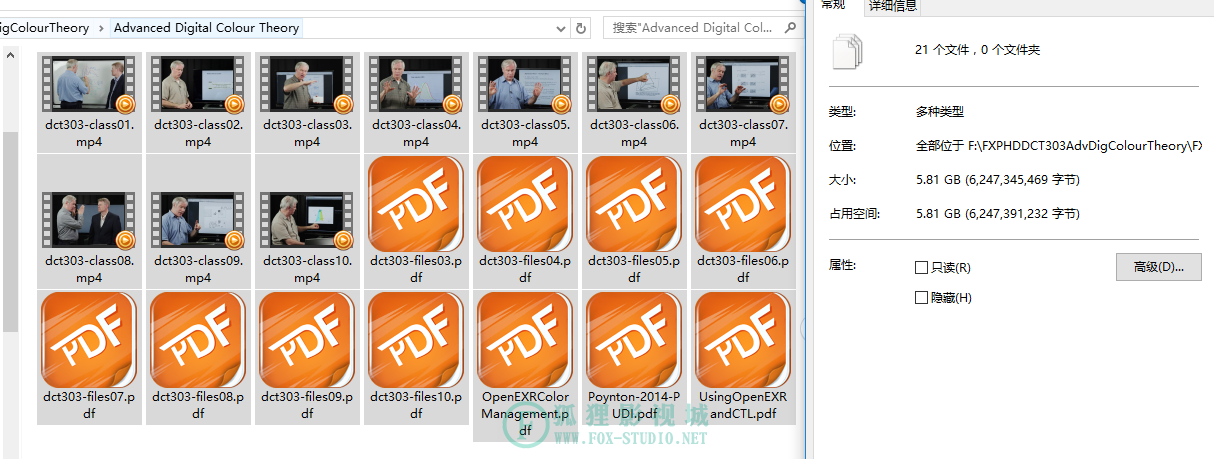 文章源自狐狸影视城-https://fox-studio.net/31617.html
文章源自狐狸影视城-https://fox-studio.net/31617.html
960*540 | MP4 | 10节课程 | 8小时58分 | 英文无字幕 | 包含pdf文件 | 5.81GB文章源自狐狸影视城-https://fox-studio.net/31617.html
色彩理论的讲解,全部是英文。文章源自狐狸影视城-https://fox-studio.net/31617.html
【电脑翻译】文章源自狐狸影视城-https://fox-studio.net/31617.html
彩色图像编码是数字成像的核心,是高质量数字电影和高清制作的关键因素之一。在这个过程中,我们遵循颜色从它的光谱形式在前面的相机到收购,颜色减少到3个组成部分,然后通过后的生产,分级,整理,批准,掌握,分发,和显示/展览阶段。我们讨论了颜色变换和colourspaces用于所有这些阶段。我们讨论了采样和压缩颜色方面(H.264,在佳能相机的ProRes,在Alexa和JPEG2000,如用于DCPS)。文章源自狐狸影视城-https://fox-studio.net/31617.html
我们目前的许多图表,图形,并用数学方程在中间水平;我们希望你与y = mx + B比较熟悉,与矩阵,有些熟悉、幂函数和对数。(警告:主持人是加拿大人,颜色将拼写与一个“U”。文章源自狐狸影视城-https://fox-studio.net/31617.html
1级:颜色科学的技术介绍:我们介绍了物理使用牛顿的绘画从一年1666的光谱功率分布。我们介绍了CIE标准观察者,和三刺激值(“三色色”),从SPD应用这些权重函数的结果。我们得到的RGB值,并显示RGB混色。我们回顾了CMY电影编码,并回顾经典的CPD / DPX密度编码系统。文章源自狐狸影视城-https://fox-studio.net/31617.html
2类:感性的统一编码:我们定义的线性度的概念,并解释为什么它是重要的现代成像系统。我们定义的亮度。我们引入幂函数和对数。我们讨论的code-100问题。我们问,什么位深度是必要的代表现实?需要什么样的深度来满足人类的视觉?文章源自狐狸影视城-https://fox-studio.net/31617.html
3班:林,日志,和quasilog编码:有两种“线性”的采集和两种“日志”采集;阐述。我们列出了各种专有的日志格式。我们讨论了理论和实际方面的收购编码。文章源自狐狸影视城-https://fox-studio.net/31617.html
4级:颜色变换:有许多种颜色变换:仿射变换(3×3线性矩阵,LMS,XYZ,RGB colourspaces,也y'cbcr空间)、射影变换变换(用于CIE xy),和各种非线性变换(包括CIE Lab)。我们讨论的3D LUT,色域映射,和ICC色彩管理系统。文章源自狐狸影视城-https://fox-studio.net/31617.html
5类:ACES工作流程,colourspaces,和变换:现场称线性光图像编码是快速成为做高端生产的标准方法。我们描述的王牌和办公室colourspaces,和王牌颜色变换:IDT,LMT,RRT,RDT和ODT。文章源自狐狸影视城-https://fox-studio.net/31617.html
6类:我们解释相机3 - 3矩阵的理论和实践的必要性。我们描述了如何建立一个由真正的相机的RGB(设备空间)的王牌交换–colourspace,我们解释了如何建立一个王牌输入装置的改造,IDT。我们还讨论了为什么IDT有照明的依赖。文章源自狐狸影视城-https://fox-studio.net/31617.html
7类:视频编码:我们目前伽玛系统概况,包括数字电影DCI标准(2.6),HD的bt.1886标准(2.4)和桌面计算的sRGB标准(2.2)。我们回顾色度抽样(4:4:4、4:2:2,4:2:0),并讨论了噪声,影响分辨率和位深度。文章源自狐狸影视城-https://fox-studio.net/31617.html
8类:分布:DCI P3详细图像编码用于参考数字影院投影机描述我们与XYZ编码实践。我们勾勒出ProRes,H.264压缩和JPEG2000的相关问题。文章源自狐狸影视城-https://fox-studio.net/31617.html
9类:高清,2K,4K,8K(“UHD”):我们详细介绍了当前和未来的图像格式,并讨论了空间采样,重采样和重采样的基本理论。文章源自狐狸影视城-https://fox-studio.net/31617.html
10级:紧急显示系统:宽色域的颜色正在迅速崛起。我们讨论了LED背光液晶显示器;OLED;激光显示;空间调制的背光和高动态范围显示。我们还讨论了在紧急显示观察员同色异谱问题。文章源自狐狸影视城-https://fox-studio.net/31617.html
文章源自狐狸影视城-https://fox-studio.net/31617.html
文章源自狐狸影视城-https://fox-studio.net/31617.html
【英文介绍】
Colour image coding is at the heart of digital imaging; it is a critical element of high-quality digital cinema and HD production. In this course we follow colour from its spectral form in front of the camera into acquisition where colour is reduced to 3 components, then through the post-production, grading, finishing, approval, mastering, distribution, and display/exhibition stages. We discuss the colour transforms and colourspaces used at all of these stages. We discuss colour aspects of subsampling and compression (H.264, as in Canon cameras, ProRes, as in Alexa, and JPEG2000, as used in DCPs).文章源自狐狸影视城-https://fox-studio.net/31617.html
We’ll present lots of diagrams, graphs, and equations using math at intermediate level; we hope that you’re quite familiar with y = mx + B, and somewhat familiar with matrices, power functions, and logarithms. (WARNING: The presenter is Canadian; colour will be spelled with a “u”.)文章源自狐狸影视城-https://fox-studio.net/31617.html
Class 1: Technical introduction to colour science: We introduce the spectral power distributions of physics using Newton’s drawing from the year 1666. We introduce the CIE standard observer, and the tristimulus values (“tristimuli”) that result from applying those weighting functions to SPDs. We derive RGB values, and demonstrate RGB colour mixtures. We review the CMY coding of motion picture film, and review the densitometric coding of classic CPD/DPX systems.文章源自狐狸影视城-https://fox-studio.net/31617.html
Class 2: Perceptually uniform coding: We define the concept of linearity, and explain why it is important in modern imaging systems. We define lightness. We introduce power functions and logarithms. We discuss the code-100 problem. We ask, what bit depth is necessary to represent reality? What bit depth is required to satisfy human vision?文章源自狐狸影视城-https://fox-studio.net/31617.html
Class 3: Lin, log, and quasilog coding: There are two kinds of “linear” acquisition and two kinds of “log” acquisition; we elaborate. We outline various proprietary log formats. We discuss theoretical and practical aspects of acquisition coding.文章源自狐狸影视城-https://fox-studio.net/31617.html
Class 4: Colour transforms: There are many kinds of colour transforms: affine transforms (3×3 linear matrix, in LMS, XYZ, RGB colourspaces, and also in Y’CBCR spaces), projective transforms transforms (used in CIE xy), and various nonlinear transforms (including CIE LAB). We discuss 3D LUTs, gamut mapping, and ICC colour management systems.文章源自狐狸影视城-https://fox-studio.net/31617.html
Class 5: The ACES workflow, colourspaces, and transforms: Scene-referred linear-light image coding is fast becoming the standard way to do high-end production. We describe the ACES and OCES colourspaces, and the ACES colour transforms: IDT, LMT, RRT, RDT, and ODT.文章源自狐狸影视城-https://fox-studio.net/31617.html
Class 6: We explain the theoretical and practical necessity of a camera 3×3 matrix. We describe how to build a transform from real camera RGB (device space) to the ACES interchange colourspace – that is, we explain how to build an ACES input device transform, IDT. We also discuss why IDTs have illumination dependencies.文章源自狐狸影视城-https://fox-studio.net/31617.html
Class 7: Video colour coding: We present a systematic overview of gamma, including the DCI standard for digital cinema (2.6), the BT.1886 standard for HD (2.4) and the sRGB standard for desktop computing (2.2). We review chroma subsampling (4:4:4, 4:2:2, 4:2:0), and discuss its effects on noise, resolution, and bit depth.文章源自狐狸影视城-https://fox-studio.net/31617.html
Class 8: Distribution: We describe in detail the DCI P3 image coding used for reference D-cinema projectors, and the XYZ coding for DCPs. We outline compression issues associated with ProRes, H.264, and JPEG2000.文章源自狐狸影视城-https://fox-studio.net/31617.html
Class 9: HD, 2K, 4K (“UHD”), 8K: We detail current and future image formats, and we discuss the underlying theory of spatial sampling, resampling, and oversampling.文章源自狐狸影视城-https://fox-studio.net/31617.html
Class 10: Emergent display systems: Wide gamut colour is emerging rapidly. We discuss LED backlights on LCD displays; OLED displays; laser displays; spatially modulated backlights and high dynamic range displays. We also discuss the open issue of observer metamerism in emergent displays.文章源自狐狸影视城-https://fox-studio.net/31617.html
文章源自狐狸影视城-https://fox-studio.net/31617.html
 文章源自狐狸影视城-https://fox-studio.net/31617.html
文章源自狐狸影视城-https://fox-studio.net/31617.html
文章源自狐狸影视城-https://fox-studio.net/31617.html
文章源自狐狸影视城-https://fox-studio.net/31617.html

2016年6月22日 下午9:40 1F
越权操作?
2016年6月23日 下午12:02 B1
@ 张恺麟 已修复,重新下载